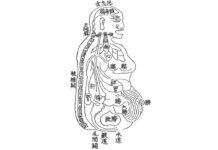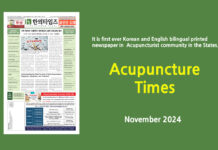By By Manyong Park, Sungchul Kim, KMD, Wonkwang University Korean Medical Hospital, Department of Acupuncture & Moxibustion, Gwangju, Republic of Korea, ALS Center of Wonkwang University Korean Medical Hospital, Gwangju, Republic of Korea
The original manuscript that described Saam acupuncture is estimated to have been published between 1644 and 1742, in the middle of the Cho Sun dynasty, by a Korean Buddhist monk whose name is unknown. Because Chimgoogyeong- heombang (Experiential Prescriptions of Acupuncture and Moxibustion), which was published in 1644, is quoted in the manuscript of Saam acupuncture, the publication period of the Saam acupuncture manuscript can be estimated to be after 1644 [10]. After 1742, Gy-san’s clinical experience was added to the original manuscript of Saam acupuncture, that is, Gyeongjeyogyeol (Essential Rhymes on Acupuncture and Moxibustion by Master Saam). This is the oldest existing manuscript associated with Saam acupuncture. The physiol- ogy, pathology, and disease identification sections of Saam were handed down to its disciples, but the clinical experience section of Gy-san coexists in the currently published Saam acupuncture-related books [11].
Viscera/bowel-based acupuncture was developed in Chimgoogyeong-heombang (Experiential Prescriptions of Acupuncture and Moxibustion), with integration of the meridian/exterior theory with the viscera manifestation theory, which in turn provided various methods for viscera diagnosis. Viscera identification became the basis of Saam acupuncture treatment [12].
The Dongeuibogam (Treasured Mirror of Eastern Medicine) contains the following phrase: “One acupuncture needle in all the diseases, up to within four acupuncture needles, acupuncture on the whole body is not a good idea.” This phrase represents the characteristics of the traditional Korean acupuncture method. In this context, Saam acupuncture treated the disease within four acupuncture
points. Further, an acupuncture method based on the five element principles is presented in the acupuncture section of the Dongeuibogam. The idea of treating a disease derived from viscera/bowel dysfunction by using five shu points influenced Saam acupuncture [1].
③ The Basic Theory of Combining Five Shu Points in Saam Acupuncture
The following phrase is taken from the 69th chapter of Nan- jing: “In the case of depletion, fill the respective mother, in the case of repletion, drain the respective child, one must fill the first and then drain afterward.” Gao-Wu, of the Ming Dynasty of China (1519 A.D.), was the first acupuncturist to describe the use of tonification and sedation points along the self-meridian by using the five shu points according to the 69th issue of Nan-Jing. Zhang Shi Xian advocated the use of five shu points in other meridians in Jiao Zheng Tu Zhu Nan Jing (Illustrated note of Classic of Difficult Issues) [11]. On the basis of Gao-Wu and Zhang Shi Xian treatment, Saam added the role of the governor. This notion originated from the 50th and 75th chapters of Nan-Jing.
In Saam acupuncture, the relationship with the governor is important, as is the relationship between the mother and son. The governor is sedated under the condition of deficiency and is tonified under the condition of excess [13]. The basic rules are those of the creation and governor relationships. In the case of insufficiency of any meridian, the mother points of its mother and its own meridians should be tonified and the governor points of its governor and its own meridians should be sedated. For example, the following is applied if the lung meridian is diagnosed as deficient: earth tonification, lung meridian-earth point LU9 and spleen meridian-earth point SP3 and fire sedation, lung meridian- fire point LU10, and heart meridian-fire point HT8 (Table 1). The other meridians follow the same rule, as described above. In the case of the excess of any meridians, the governor points of its governor and its own meridians should be tonified and the son points of its son and its own meridians should be sedated. For example, the following is applied if the lung meridian is diagnosed to be excessive: fire tonification, lung meridian-fire point LU10, and heart meridian-fire point HT8 and water sedation, lung meridian-water point LU5, and kidney meridian-water point KI10 (Table 2).
Another simple but rarely used one is coldness-fire acupuncture treatment derived from the deficiency-excess acupuncture treatment. For cold symptoms, the fire points of its own and the fire meridians are tonified and the Water points of its own and the water meridians are sedated. For heat symptoms, the water points of its own and the water meridians are tonified and the fire points of its own and the fire meridians are sedated (Table 2).
Among the clinical case studies of Saam, 85% used either a tonification or a sedation formula, whereas 15% used variations of the tonification and the sedation formulae [13]. Saam treatment primarily focuses on the viewpoints of deficiency-excess symptoms rather than cold-heat symp- toms [1]. The 240 acupuncture treatments described in the Gyeongjeyogyeol consist of 100 regular forms on the basis of
the 69th issue of Nan-Jing, 140 irregular forms on the basis of the 73rd and 75th issues, and various special acupuncture points, which include the source, connecting, accumulation, alarm, and back-transporting points [14].
Table 1: Saam’s combination of five shu points for deficiency and excess of the meridians.

Table 2: Saam’s combination of five shu points for cold and heat symptoms of the meridians.

References
[1] O. Jung, D. H. Lee, and S. W. Ahn, “A research for tradition and identity of Saam acupuncture method,” Korean Journal of Acupuncture, vol. 29, no. 4, pp. 537–553, 2012.
[10] D. H. Kim, “The literary study on the written date and the background of Sa-Ahm’s 5 element acupuncture method,” Journal of Korean Medical Classics, vol. 7, pp. 113–160, 1993.
[11] S. C. Kim, J. H. Won, and K. W. Kim, Korea Traditional Sa-Am Acupuncture, Jimoondang, 2009.
[12] J. Oh and N. Ki, “A study on the acupuncture methods of Joseon Dynasty using five viscera diagnosis,” Korean Journal of Oriental Medicine, vol. 16, no. 4, pp. 1–31, 2010.
[13] R. Cha, D. Yoon, J. Kim, M. Lee, and G. Lee, “A study of Sa- Ahm’s thoughts on the four-needle acupuncture technique with the five-element theory,” Journal of Acupuncture and Meridian Studies, vol. 7, no. 5, pp. 265–273, 2014.
[14] A. Hicks, J. Hicks, and P. Mole, Five Element Constitutional Acupuncture, Churchill Livingstone, Edinburgh, UK, 2005.


































